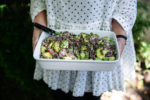
A Green Quarantine: Pandemic Pantry Prep
15 foods to always have on hand.
We may all be home right now, but most of us aren’t on vacation. Whether we’re busy working, taking care of kids, or just figuring out what our new (ab)normal looks like, there is plenty happening inside our houses, as well as our bodies and minds.While cooking is the perfect way to take a break from working, it can also be quite time-consuming. There are so many things to be stressed about right now, but eating shouldn’t be one of them.
So, voilà! BWB has some tips to keep your pantry stocked so that you can whip up a healthy meal in minutes. Unfortunately, fresh produce may not always be available these days. If you can get it– great! Add fresh vegetables, fruits, herbs and greens to anything and everything! But if you are shopping for 1-2 full weeks at a time, here are some tips for your pandemic pantry prep.
1. Great Grains

RICE: Do not underestimate this humble ingredient. In fact, Auguste Escoffier devoted an entire book to it! People have been eating rice for centuries, from ancient Chinese sages to Okinawans to Alexander the Great. As a result, rice has become a staple thanks to both its versatility in recipes and its health benefits. Aim for brown varieties instead of white, since they keep the fiber and nutritional benefits intact (plus, a heartier texture and more robust flavor!). Short grain, long grain, basmati, Thai, jasmine, red or black (seed) – variety is the rice of life!
QUINOA: In my kitchen, we call it quarantinoa! This seed is gluten-free, high in protein (all 9 essential amino acids) and contains fiber, magnesium, B vitamins, iron, potassium, calcium, vitamin E and antioxidants. Start by making a batch to store in the fridge during the week (3-5 days). Then, you can use it for salads, curries, “quinottos” (just what is sounds like– risotto with quinoa) or breakfast porridges. Soak it overnight with a splash of lemon or apple cider vinegar to make it more easily digestible and less bitter.
BUCKWHEAT: In my option, this is still one of the most underrated gluten-free grains! Add it dry to granola mixes before baking or cook it to add as a side dish or base for a main. It’s a great source of protein, fiber and nutrients.
OATS: Oatmeal has always been my ultimate comfort food – soothing, warming and sweet! Oats are great for making granola or a quick, hearty breakfast. As a bonus, granola makes your entire house smell like cake. Have it for snack or even lunch or dinner – anything is acceptable in a pandemic! Play with different plant-based milks, dried or fresh fruits and spices. Also, try some savory versions with onion, garlic, nutritional yeast and unsweetened coconut milk.
2. Go Nuts!
It’s not a secret that nuts are great sources of protein, fiber and nutrients. Almonds, walnuts, cashews, pistachios – so many nuts, so little time. (Or in this case, too MUCH time!) Each nut has its own unique nutritional profile, texture and flavor. For example, cashews are perfect for plant-based cheese, creams or milks, while toasted walnuts add nutty flavor and “meaty” textures to any dish. I love to make a “faux-mesan” with toasted almonds and nutritional yeast.
Toast nuts and add them to any dish for added crunch and flavor. You can also soak and blend nuts with coconut water or water for DIY nut milks. Then, use these milks as bases for your oatmeal, cereal, smoothies, lattes or soups! You can even make your own nut butters! If not, buy store-bought varieties – almond butter, peanut butter, cashew butter. Regardless, these are all great to add to anything and everything. Make delectable plant-based sauces or simply spread on toast with some bananas for a healthy snack.
3. Don’t Worry, Be Hempy
Hemp seeds are a must in any plant-based pantry. They’re easily digestible and, unlike other nuts and seeds, don’t need to be soaked or toasted. Hemp is one of the best sources of plant-based protein, and it also contains high amounts of vitamin E, omega-3 fatty acids, iron, zinc, potassium, phosphorous, magnesium and calcium. Add hemp seeds to any sweet or savory dish to transform a simple salad into a protein-packed meal.
For a delicious topping, try mixing with some nutritional yeast, toasted fennel seeds and a pinch of Himalayan salt.
4. The Yeast You Can Do
Nutritional yeast sounds scary, but it tastes like cheese! This unique ingredient comes in the form of a flakey powder. It’s filled with protein, antioxidants, minerals and vitamins – particularly the elusive B varieties. Want some parmesan cheese for your pasta? Add it to seeds or toasted nuts for an alternative. Looking to for creamier or cheesier soups? Throw some nutritional yeast in! Craving cheese but don’t have any? Blend it with cashews, salt and pepper for an easy alternative (Don’t believe me? Taste it!). Plus, it lasts for a long time in the pantry so it’s perfect for a pandemic.
5. Drop Some Acid: Vinegars

APPLE CIDER VINEGAR: ACV has been used for centuries in both cooking and medicine. Pimples? Put it on your face! Washing fresh produce? Use apple cider vinegar! Having trouble digesting? Drink a combination of warm water and ACV before meals! Not feeling well? Add a splash to hot water and inhale it with a towel on your head. ACV is also a key ingredient in vinaigrette (mix with olive oil, turmeric, black pepper, tahini and a bit of honey or maple syrup). Its antimicrobial properties can help kill harmful bacteria, lower blood sugar, aid digestion and boost skin health. I love adding it to sautéed veggies or tomato sauces because it adds both sweet and savory flavors, but consuming it raw keeps all the nutrients intact.
UMEBOSHI VINEGAR: Ume – what? This fancy-sounding ingredient is, in fact, quite affordable and versatile. Japan has used it for centuries as both food and medicine – but food is medicine, haven’t you heard? Made from a fermented plum and shiso, umeboshi eliminates toxins and aids digestion. Its salty, sour, fruity taste transforms any dish into pure “umami” deliciousness. For a quick dinner, mix it with tahinito top a simple bowl of rice and steamed veggies. You can also add a splash to some avocado and veggies, and then wrap it all with a nori roll for sushi that still hits the spot.
6. Pimp Your Powders

There are dozens – even hundreds – of superfood powders on the market, but here are some of my favorites:
MATCHA POWDER: Now that you finally have time to adopt an ancient Japanese tea ceremony, go for it! Blend this famed green tea powder (rich in antioxidants and energizing l-theanine) with nut milk for a delicious latte.
TOCOTRIENOLS POWDER: This powder, made from rice bran solubles, quite simply tastes like vanilla cake. It also happens to be a well known “skin food” that hydrates skin and connective tissue. Add it to smoothies or homemade lattes for an extra boost.
MACA POWDER: Shake what yo maca gave ya. No, really – this root may make you want to get up and dance. Maca powder is incredibly energizing and also helps to balance hormones for women. I love its unique, fruity flavor. Try it in a maca latte made with nut milk, cinnamon and ginger.
CACAO POWDER: This one is nonnegotiable. Chocolate is necessary for survival – confirmed. For a quick & easy chocolate mousse, blend with an avocado, a soft Medjool date, pinch of salt, cashew milk and mesquite powder (optional). Mesquite powder tastes like caramel, and it is rich in vitamins and fiber!
THE LOCKDOWN LATTE
For 1 Latte (but don’t hesitate to double triple quadruple the recipe and leave in the fridge, then warm up whenever you want to enjoy it)
- 1 cup or 250 mL of coconut water
- 1 tbsp (white/blanched is my favorite but any will do) almond butter
- 1 pinch of powdered cinnamon
- 1 small piece of grated fresh ginger (to taste) or ginger powder
- 1/2 tsp matcha powder
- 1/2 tsp maca powder
- 1/2 tsp spirulina powder
- 1 tsp coconut oil
- 1 teaspoon honey
- Optional: 1 tbsp tocotrienol powder (rice powder rich in vitamins and minerals, which also brings a taste of vanilla cake)
Mix all the ingredients in a blender except the oil and honey, then pour into a saucepan and heat over medium heat adding the coconut oil. Mix well and pour into a mug, add the honey and slowly sip this latte to let its magic permeate your body and soul!
7. Spice things up!

People of the world, spice up your life! A pantry without spices is like the Spice Girls without Posh spice – technically possible, but far less interesting.
CINNAMON: Cinnamon is an anti-inflammatory antioxidant that adds sweetness while lowering blood sugar levels. But, it’s not just for sweet concoctions! Cinnamon is, of course, a must in any breakfast or dessert, but it’s also great in vinaigrettes, curries or sweet potato dishes. For example, peel & cut up a sweet potato, mix with coconut oil, add salt/pepper & a pinch of cinnamon and roast (at around 400° for around 25 minutes).
TURMERIC: Rich in curcumin, this bright orange spice is a remarkably powerful antioxidant. Because it is also an incredible anti-inflammatory, turmeric is great for aches, pains and digestive distress. You can use either a fresh variety (your hands and countertops will likely turn orange for the foreseeable future) or a powdered spice form. To increase its power, make sure to always eat it with its BFF (best friend food), black pepper.
CAYENNE: It’s getting hot in here, so take off all your clothes (go ahead, no one can see you since you’re in your home, right?). Cayenne not only packs a peppery punch to add heat to any dish, but it also improves circulation, boosts digestion and helps reduce appetite and burn fat.
SMOKED PAPRIKA: This makes everything taste like bacon! Add a dash to soups, sauces or sandwiches and prepare to be dazzled.
8. The Roots, The Roots Are On Fire!
Ginger has been used for centuries in alternative medicine to combat many different ailments, particularly in the digestive category. In fact, ginger can treat nausea and indigestion; it is also an anti-inflammatory that helps with pain. I love to add it to my morning Lockdown Latté, smoothie or oatmeal, but you can also use it in savory dishes. Add a slice to the water when cooking rice, or sautée with garlic and onion for soups or curries.
9. Sweet Nothings

HONEY: Hi honey, you’re home! Honey (raw, local and organic) is a great source of antioxidants and phytonutrients. This antibacterial and anti-fungal sweetener can soothe a sore throat or ease digestion, too. Honey literally makes life sweeter, so don’t be afraid to add a drizzle to anything you’re eating. Just try not to go overboard – it still affects your blood sugar levels even thought it has so many health benefits!
DATES: Exciting news: Confinement doesn’t mean you can’t have a hot date – as long as it’s of the Medjool variety. Dates are a great way to add sweetness and fiber, plus a bit of potassium, magnesium, copper, iron, manganese, iron and vitamin B6. Soak them in warm water until they get soft, peel, remove the pit and blend into any concoction like homemade nut milk or my chocolate mousse recipe above.
10. Cool Beans!
Legumes are loaded with fiber, protein, complex carbohydrates and several vitamins and minerals. You can eat them from the can or soak, cook (add kombu to ease digestion) and store in the fridge to eat for several days. Add to salads, big “buddha” bowls, or blend with tahini and garlic to make homemade hummus. My favorites are chickpeas, peas and lentils!
11. Home, Sweet Potato, Home.
Sweet potatoes are a wonderful source of fiber, vitamins and minerals. Specifically, they’re a great source of vitamin A, which helps the body fight off infections. They’re low on the glycemic index and high in magnesium, which helps to reduce stress and anxiety (see: global pandemic!). Bake in the oven with some coconut oil and top with cashew cream, or stuff with quinoa and roast with coconut oil, or simply steam! Use them to thicken creamy soups or purée them in desserts to replace butter and oils.
12. You Can Call Me Alliums
Keep it in the family. Onions, garlic, leeks, shallots and scallions are all part of the Allium family. Known for their pungent flavors, they also have many health benefits like quercetin – a powerful antioxidant with anti-inflammatory effects. Garlic and onions boost the immune system and help to fight viruses and bacteria, while leeks contain folate and vitamin C.
For an easy soup recipe: Sautée garlic, onion and/or leeks in olive or coconut oil in a pot until translucent. Then, add a mix of broth (homemade or store-bought), coconut milk, sweet potato, carrots and cauliflower. Finally, blend together.
13. Oil You Need Is Love

COCONUT OIL: Coconut oil is great for cooking at higher temperatures. Use it to sautée greens or veggies on a pan or roast them in an oven. You can also add a spoonful when cooking rice or other grains for a buttery taste. Try mixing coconut oil with miso paste – spread on toast, add to pasta or mix in rice – because it tastes like butter! It contains healthy fatty acids and has antimicrobial effects. While rich in fat, it can also help to burn fat. Additionally, it’s a great moisturizer for skin, lips and hair.
OLIVE OIL: A key ingredient in the Mediterranean diet, olive oil contains monounsaturated fatty acids. Don’t be afraid; this fat won’t make you fatty. These are considered healthy dietary fats, particularly oleic acid that can reduce inflammation. This antibacterial oil is rich in anti-oxidants and vitamins E & K. It also has the magical power to make most food taste better! Add to salads, drizzle over steamed veggies, or add to pasta and rice. It’s best when not used under high heat.
14. Say Ch… ia!
Chia seeds are a hippie food cliché that is thousands of years old. The Aztecs first used chia as early as 3500 B.C. These tiny black and white seeds pack a powerful protein punch filled with fiber, antioxidants and omega-3 fatty acids. Eat them whole, grind them or mix them with liquid to create a plant-based egg alternative for baked goods. They’re the ideal quarantine food for busy people: Mix with nut milk and some nuts, seeds or dried fruits, leave in the refrigerator overnight and top with some fresh fruit when you serve it the next morning. Or, add some oats to the mix for a delicious muesli blend. You can also mix them into puréed fruits and store in the fridge for a sugar-free alternative to jelly. Give it a try the next time you’re craving a PB&J!
15. Avocado, Mon Amour
Last, but certainly not least… Avocados. For an easy anytime meal or snack, just smash one up and add to toast. You can also blend into desserts or smoothies, add to soups or sauces, or toss in salads or giant bowls of grains, legumes and veggies. Avocados are a great source of fiber, vitamins, folate, lutein, beta-carotene and omega-3 fatty acids (the good fats!).

Rebecca Leffler is a Paris-based writer and journalist who, after a career as the French correspondent for The Hollywood Reporter and as a film critic on Canal+, traded red carpets for green smoothies. She’s written five books about healthy lifestyle from Paris to NYC and beyond, including Très Green, Très Clean, Très Chic: Eat (and Live!) the New French way with plant-based, gluten-free recipes for every season, and most recently Le Nouveau Manuel de la Cuisine Végétale. Rebecca has pioneered the “vegolution” in Paris, where she continues to organize events focusing on healthy eating, yoga and la vie en rose… And green! You can keep up with Rebecca on Instagram!






